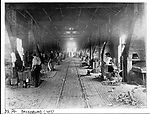 Large Chain Shop
Large Chain Shop Feel the Heat
Feel the Heat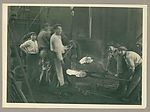 'ommer it!
'ommer it! Ready to Go
Ready to Go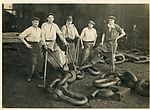 We Made This
We Made This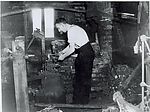 Small Chain Shop
Small Chain Shop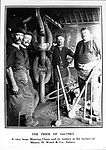 Tools of the Trade
Tools of the Trade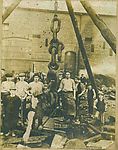 Children at Work
Children at Work Breeze Oven
Breeze Oven

The factory system of chain making began in the early nineteenth century because the Navy wanted strong anchor chain. The Black Country chosen as it had good quality wrought iron and coal.
In the 1820s Noah Hingley brought cable-chain manufacture to the Black Country. First came small workshops at the employers' houses with workers from outside to help them. As business grew they would move to larger premises, although outworkers were still used as and when they were needed.
After Hingley’s of Netherton, others began to manufacture in the region, and by the end of the century thousands of people were employed in factories across the Black Country.
A chain shop would have an hearth for each chainmaker with all the tools needed. Makers of small chain worked alone, but those making large chain would have up to three strikers working with them, who would use large hammers while the Smith held the tools. The chainmakers working on large chain began work early so they could finish before it got hot.
Coal used to heat the wrought iron was known as breeze (coke). Breeze needed a good blast of air to keep it hot enough, so each hearth had bellows, the larger works had compressed air made by a steam engine
Women only made chain from rods of up to 3/8in (10mm) diameter. Men would make chain from rods of up to 6ins (150mm) diameter. The chain made by women would be for farms and gardens. Chain made by men was used for ships' cables, cranes and pulleys, where safety was an issue. Children were used in the workshops, usually to operate the bellows for the blast.
A small employer had about six people, mostly doing work for one of the larger companies. The largest companies employed up to one hundred people on chainmaking. Sometimes several members of the same family would work at the same factory all of their lives. In 1866 2,000 men and boys worked in 235 factories. They were paid for each piece they made, those making the largest and best quality chain earning the most.
Although some of the larger firms offered apprenticeship schemes, most learnt their trade from other family members.
Rollover the captions in the box to see the available images in thumbnail format, click the caption to see the full-size image
| Reference: | 657 |
| Keywords: | |
| Archive Ref: | |
| Updated: | Wed 21 Mar 2007 - 1 |
| Interpretation written by | Louis Howe |
| Author's organisation | Curatorial |
| Organisation's website |